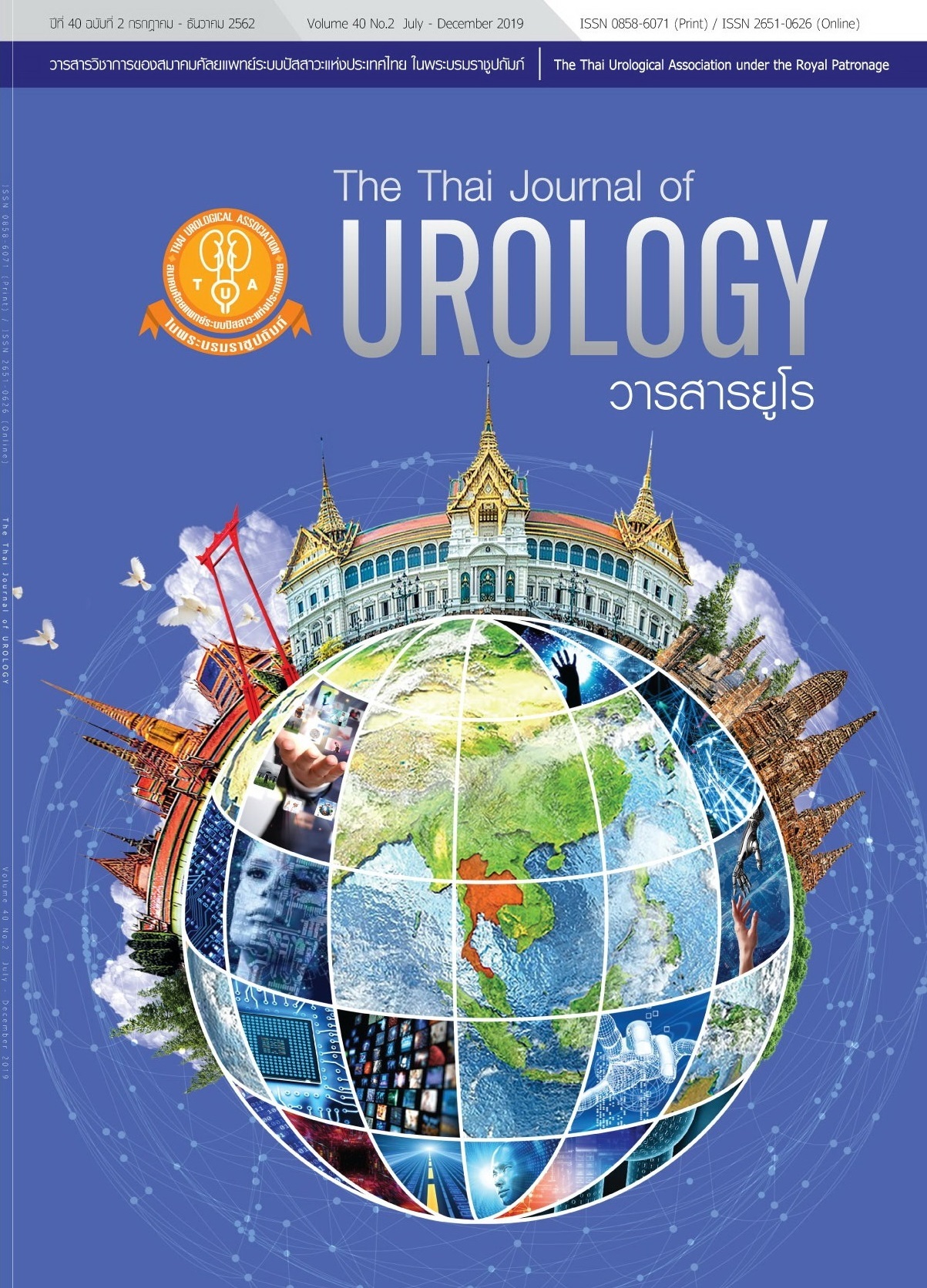Investigation into a Possible Association between Telomere Length in Prostate Cancer patients and Non prostate cancer patients
Keywords:
: Prostate cancer, Leukocyte telomere length, Telomere, Metabolic syndromeAbstract
Investigation into a Possible Association between Telomere Length in Prostate Cancer patients and Non prostate cancer patients
Karuha Martwachira1, Navakun Kaewtunjai2, Wirote Tuntiwechapikul2, Bannakij Lojanapiwat1
1Division of Urology, Department of Surgery, Faculty of Medicine, Chiang Mai University, Thailand
2Department of Biochemistry, Faculty of Medicine, Chiang Mai University, Chiang Mai, Thailand
Abstract
Background
Aging is one of the non modifiable risk factors for many medical conditions including malignancy, metabolic syndrome and cardiovascular disease. Telomeres are the protective structures at either end of each chromosome. The length of the telomere is known to be a marker of biological aging. Telomeres in normal cells shorten with each cell division resulting in cellular senescence and cell death. Cancers cell have protective mechanism to prevent cell death. Several studies have shown that shorter leukocyte telomeres predict a high risk of malignancy
Objective
To investigate a possible association between leukocyte telomere length (LTL) in prostate cancer patients and that in non prostate cancer patients.
Methods
Enrollment criteria for the study were: patients over 50 years of age who were being screened for prostate cancer or had an abnormal digital rectal examination, those whose serum PSA was more than 4 ng/dL or had increased more than 0.75 ng/dL per year
Clinical data and laboratory data were recorded and participants were divided into 2 groups a prostatic cancer patients group and a non prostatic cancer group as dictated by the pathological findings. We compared the leukocyte telomere length in each group. The primary outcome was the LTL in the prostatic and non prostatic cancer group. The secondary outcome was what affected the LTL in Prostate cancer patients. Univariable and multiple linear regression analytical outcomes were compared. A p-value < 0.05 was deemed to be statistically significant.
Results
200 patients were included in the study, 87 in the prostatic cancer group and 113 in the non prostatic cancer group. Baseline characteristic of participants are summarised in Table 1. The mean age of the cancer patients was 70.09 years and 67.61 years in non cancer group
The mean LTL was 5.37 in the prostatic cancer group and 5.40 in the non prostatic cancer group (p=0.736). The mean serum PSA was significantly higher in the prostatic cancer group compared with the non prostatic cancer (307.76 vs 11.80, respectively) (p<0.001).
This analysis showed that older age (60 years plus) was significantly associated with shorter leukocyte telomere length (P=0.01). However other factors were not associated with leukocyte telomere length (Table 2).
Conclusions
In this prospective study leukocyte telomere length was not significantly different between the prostatic cancer group and the non prostatic cancer group. Aging (60 years old plus) and distant organ metastasis were significantly associated with leukocyte telomere length
References
2. Soleiman Mahjoub, Matthias Krams(2006), Comparison of telomerase activity in prostate cancer, prostatic intraepithelial neoplasia and benign prostatic hyperplasia, Journal of Research in Medical Sciences July & Aug. 2006; Vol 11, No 4.
3. Wu X, Amos CI, Zhu Y, Zhao H, Grossman BH, Shay JW, Luo S, Hong WK, Spitz MR (2003) Telomere dysfunction: a potential cancer predisposition factor. J. Natl Cancer Inst. 95, 1211–1218.
4. Broberg K, Bjo¨ rk J, Paulsson K, Ho¨ glund M, Albin M (2005) Constitutional short telomeres are strong genetic susceptibility markers for bladder cancer. Carcinogenesis. 26, 1263–1271.
5. McGrath M, Wong JYY, Michaud D, Hunter DJ, De Vivo I (2007) Telomere length, cigarette smoking, and bladder cancer risk in men and women. Cancer Epidemiol. Biomarkers Prev. 16, 815–819.
6. Balasubramanyam M, Adaikalakoteswari A, Monickaraj SF, Mohan V (2007) Telomere shortening & metabolic/vascular diseases. Indian J. Med. Res. 125, 441–450.
7. Cathy E. Elks and Robert A. Scott(2014) The Long and Short of Telomere Length and Diabetes, Diabetes 2014;63:65–67
8. Zhao J, Zhu Y, Lin J, et al. Short leukocyte telomere length predicts risk of diabetes in American Indians: the Strong Heart Family Study. Diabetes 2013;63:354–362
9. Giovanni Corona et al. (2014) Benign Prostatic Hyperplasia: A New Metabolic Disease of the Aging Male and Its Correlation with Sexual Dysfunctions, International Journal of Endocrinology Volume 2014, Article ID 329456, 14 pages
10. B Julin et al. (2015) Circulating leukocyte telomere length and risk of overall and aggressive prostate cancer, British journal of Cancer 2015 112, 769-776
11. Jian Gu et al. (2015) Leukocyte telomere length and Cancer risk: A dynamic problem, EBiomedicine 2 (2015) 493-494
12. Svenson et al. (2017) Long leukocyte telomere length in prostate cancer patients at diagnosis is associated with poor metastasis-free and cancer-specific survival, Tumor biology February 2017 1-7
13. Mirabello L et al. (2009) The association between leukocyte telomere length and cigarette smoking, dietary and physical variables, and risk of prostate cancer, Aging cell, vol 8; 405-413


